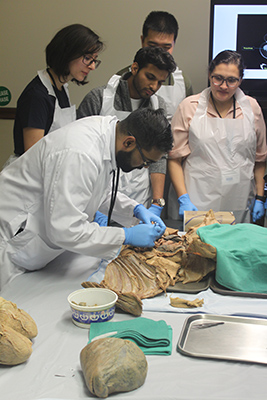Precision Training
A Radiation Oncology Bootcamp hits the mark with local and international trainees
By Kathryn Kinahan, BA’86, MLIS’93
While millions of cancer patients worldwide benefit from radiation therapy, it is not unlike other technologies – its users must keep up with the latest advances in order to get the maximum benefit from
its use.
“Radiation technology is massively different today. Think of how different your cell phone is from the early 1980s,” said Dr. David Palma, MD’04, a clinician-scientist at Schulich Medicine & Dentistry.
“Radiation technology is the same. People used to design radiation treatments for patients based on very simple technology like X-rays. Now, we use modern imaging technology – computed tomography scans, magnetic resonance imaging scans and positron emission tomography scans – that offer a more detailed look at tumours and healthy tissues,” he said.
 To gain the most from these advancements, radiation oncologists must be able to accurately read the scans, target the area to treat and identify the healthy areas to avoid. Tumours can be tricky; they can have tentacles that follow different nerves all around the body.
To gain the most from these advancements, radiation oncologists must be able to accurately read the scans, target the area to treat and identify the healthy areas to avoid. Tumours can be tricky; they can have tentacles that follow different nerves all around the body.
Residents must learn to distinguish between tumours and healthy tissue so they can deliver effective treatment. This precise task demands an equally precise understanding of anatomy.
“Take a patient with lung cancer. When we’re designing the radiation, we would outline the lung and wherever else the cancer might be. But we also have to outline the normal anatomy of the patient’s body so the computer knows where there is cancer and where there is not,” Dr. Palma said.
While Schulich Medicine & Dentistry delivers comprehensive anatomy training, that’s not the case at all medical schools.
“We realized, about six or seven years ago, that the teachings in anatomy had not kept up with the teachings in our practice. A cross-Canada survey revealed that many residents felt they weren’t getting adequate anatomy teaching,” Dr. Palma said.
Enter the Anatomy & Radiology Contouring Bootcamp for Radiation Oncology Residents.
Created by Dr. Palma, the Bootcamp brings together residents from medical schools around the world, providing them with an intensive workshop environment to learn anatomy and contouring skills from local physicians and faculty members.
Students are provided with anatomic specimens to examine, touch, manipulate and correlate with radiographic images and contouring.
“We piloted the Bootcamp in London with local residents. It’s a hands-on anatomy curriculum taught not only by anatomists, but radiation oncologists, radiologists and surgeons who are reading the X-rays and scans so the students get a multidisciplinary understanding of anatomy,” Dr. Palma said.
Feedback has been encouraging. The first Bootcamp was piloted as a research project. “We assessed anatomy knowledge before and after with a battery of tests and we found a substantial increase in the anatomy knowledge in participants,” Dr. Palma said.
After that first Bbootcamp, 100 per cent of attendees recommended it to their colleagues. That enthusiasm has continued with subsequent sessions.
“What made this course exceptional was the opportunity to take a step back and remaster the basics of anatomy. The course made me feel like a considerably stronger radiation oncology resident as I was able to integrate my refreshed knowledge into imaging and treatment plans which I know will be translatable in clinical practice,” said Dr. Neil Newman, a resident from Vanderbilt University in Tennessee.
“My daily contouring skills have definitely improved since I’ve done the course due to the evidence-based explanations and tips given in a hands-on setting. I feel the course was a unique opportunity to practise our contouring skills, guided by amazing specialists, while reviewing crucial radiology and anatomy content,” added Dr. Elson Santos Neto, from AC Caramago Cancer Centre in Brazil.
Demand for the Bootcamp has steadily increased since 2013.
When launched as a national Bootcamp, 30 residents joined in from across Canada. When opened internationally, the program attracted residents from around the world, including South America, Nepal and the United States.
While course attendance is capped to provide an intense, hand-on experience, the popularity led the organizers to contemplate ways to expand – but it’s a challenging prospect.
An online version was considered and initially abandoned. However, thanks to some new funding, they have been able to hire graduate students to create very specific videos which will be used as part of a new online version. A launch date of November 2019 has been set.








